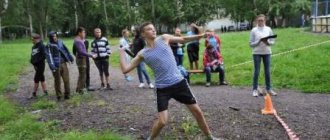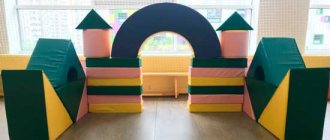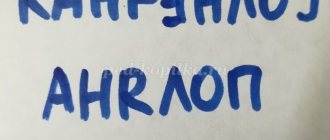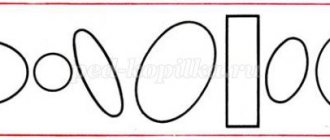Rules for conducting mathematical KVN and coming up with jokes for preschoolers
Such an event is a much more difficult task than it seems at first glance. The whole problem is that the humor of children and the humor of adults are two completely unrelated categories.
Note! The best solution to this problem would be to replace humor with some other amateur activity, say, theatrical skits or songs.
This will make it much easier to create joke math problems for preschoolers. Children will be able to prepare such work together with their parents, gathering at each other’s houses (of course, if the math quest was originally planned to be carried out in the older group).
Street dancing for girls and boys for flash mob or graduation
Note! It is imperative to ensure that there is no inequality between children, and that sufficient time is given to everyone.
It is better to leave the humorous part of the event entirely in their care. It should be remembered that it should be funny for the main participants of the holiday, and not for the parents and teachers who have gathered to watch them. A moment that is humorous for adults may not be funny for children.
At such an event, a child will be able to solve even the most difficult problem for him.
Quest game on FEMP. Counting to 20. Preparatory group
Quest game on FEMP on the topic “Journey to sea inhabitants”
Completed by: Olesya Valerievna Sushkova, teacher of MDOBU kindergarten No. 105, Sochi. Relevance : this material will be of interest to kindergarten teachers and parents for the development of mathematical abilities. Goal: development of mathematical abilities through a selection of mathematical games. Objectives : 1. Consolidate counting to 20. 2. Development of logical thinking. 3. Consolidation of the ability to analyze and make mathematical conclusions. Attributes: presentation on the topic of the week, cards with tasks. PROGRESS OF THE LESSON: Educator : Hello, guys! Today we will go on an exciting journey! And where exactly you will find out by guessing my riddle: In the sea, only under water, You can meet the land. There are starfish, pebbles and sand here. Somewhere nearby there is a menacing, important octopus walking. And the lost ships are landing here. What is this, guys? (sea bottom). - That's right, guys, this is the seabed! But you and I, guys, will not just solve problems, but for the correct answer, collect parts of a very beautiful picture and find out who lives at the bottom of the sea. Are you guys ready to go on a journey? (yes) - Well, then be careful! Task 1. Find identical shrimps . Goal: it is necessary to find an absolutely identical pair from the offered shrimps with pictures. - Well done, here's part of our picture. Task 2. Find the fish here and count them? Goal: consolidation of counting and the ability to coordinate nouns. - Great, we did it. Here's the second part of the picture. - Now, let's play with our fingers. Finger game “Fish” The fish swims in the water, (It’s fun to play with the fish’s palms folded together. They depict how the fish swims.) Fish, fish, mischievous, (They shake their finger.) We want to catch you. (They slowly bring their palms together.) The fish arched its back, (Again they depict how the fish swims.) She took a bread crumb. (They make a grasping movement with both hands.) The fish waved its tail, (They “swim” again.) The fish quickly swam away. - Well done! Next Task 3. Find the right shadow. Goal: you need to find shade for the inhabitants of the seabed. — We earned the third part of the picture. — Task 4. Find what is missing. Goal: solving logical chains. - Well done boys. Once again, you've earned part of the picture. — Task 5. Solve the example and find a pair for the whale. Goal: strengthen the ability to solve examples on addition and subtraction. (It is necessary to connect whales with examples with whales with answers, solving the examples) - Well done! Another part of the picture. - Let's rest a little. Physical education “Fish” A fish lived in a lake, The fish swam to the shore, (feet shoulder-width apart, hands on the belt, bending to the sides),
wagged its tail, looked for food for itself.
(we jump our legs to the sides, together)
There is a worm near the shore, Wriggling like this,
(hands on the belt; we make circular movements with our hips to the left and right)
The fish swims up, the worm is grabbed.
(separate the wrists and connect them)
The fishermen pulled the fishing line, but the worm broke loose,
(clap our hands in front of the chest and behind the back)
The fish was not caught, but the worm was left.
(we make wave-like movements with our palms folded together: imitation of the movement of a fish)
- Well done, guys, take your seats.
— Task 6. Find a half for the fish. You get part of the picture. — Task 7. Find the right pebble for the crab. Goal: strengthen the ability to compare objects by size. - Guys, look, we have collected all the parts of our picture. Let's fold it and see how beautiful the underwater world is. — Did you like our unusual journey? (children's answers).
“You did a good job, and now I’ll give you coloring books and we’ll color them.” (At the end of the lesson, everyone is given a coloring sheet with a picture of the seabed.)
We recommend watching:
Mathematical quiz for children of the preparatory group of a preschool educational institution Mathematical games for children of the preparatory group on the topic: “Wintering birds” Didactic games on FEMP for preschoolers 5-7 years old Didactic manual made of felt on mathematics for children 5-7 years old with your own hands step by step with photos
Similar articles:
Games with numbers for children 6-7 years old
Didactic exercises for children 5-6 years old in mathematics in pictures
Counting tasks for children 6-7 years old
Tasks in pictures for children 6-7 years old
Entertaining mathematics for preschoolers 6-7 years old. Tasks. Print pictures
summary of quest games in mathematics in the preparatory group
Scenario of a math quest game for children in the preparatory group “Journey to the Mysterious Islands”
Compiled by: Pie Ainura
Target:
To create favorable conditions for the formation of elementary mathematical concepts in preschoolers.
Tasks:
1.To consolidate temporary concepts through the development of attention and creative imagination.
2.Skills in using diagrams in solving mathematical and logical problems;
3. The ability to construct from large building materials according to a diagram, according to the instructions of the teacher, work in a group, in pairs.
4.Create conditions for the development of logical thinking, intelligence, attention, develop ingenuity, visual memory, imagination.
5.Cultivate interest in mathematical studies.
Materials
: 6-part map, ship diagram, African animals for flannelgraph, geometric figures, Cuisenaire's wand game, numbers, musical accompaniment: sound of the sea, calm music for relaxation, children's songs. Treats for children (sweets)
Progress of the game situation:
Guys! Would you like me to tell you an interesting story? It happened a very long time ago. The captain of the pirate ship "Shark", anticipating his last hour, gave his sailors a treasure map as a sign of gratitude for their long and faithful service. They decided to sail to this place. But as soon as the treasured strip of land appeared on the horizon, a serious battle for the map began among the sailors. And since everyone tried only for themselves, it was torn into small pieces. The brutal hunt for her continued for a long time, but suddenly, as if as a punishment for greed, a terrible storm hit the ship, and a few hours later the ship sank not far from the shore. Most of the crew died in the rough waters. What happened to the card? Some pieces of the map were hidden by the surviving pirates on land. The surviving pirates tried to find parts of the ill-fated map and collect it, but no one succeeded.
A lot of time has passed since then, and only two pirates have survived to this day - Bill and Jack. Aged and weakened, they are no longer able to get to the treasure on their own, and they ask us for help to help them find the map. Well, guys, let's help Bill and Jack find the map?
But it won't be easy. You need to complete all the tasks to find the map.
— Do you want to become pirates and visit different islands to collect all the parts of the map?
(children's answers)
- But how do we get to the islands? That's right, you can get there by ship.
But we don't have it. How to be?
Maybe you can tell me what a ship can be built from? (children offer their options) correctly, it can be built and the children build a ship from commercial building material based on the diagram.
Math quest and how to do it
The word “quest” comes from the English “quest”, “goal, task”; this word is also used to mark tasks in games, both computer and tabletop. In other words, a quest is a chain of tasks presented in a game form.
Note! Such an event can be done with or without a plot.
For example, children aged 5–6 years are still interested in watching the story about Baba Yaga and Little Red Riding Hood, but children aged 6–7 years may feel a little awkward.
Then it is better to put the quest in a more “adult” form, calling it, say, “Sports Math Quiz,” or make a story where the main character will be a detective, and he will investigate the case of missing answers to questions in a test. If the institution has a projector, then a background video can be installed to create the appropriate atmosphere. In order not to waste time downloading, you can launch it online. It is precisely these nuances that distinguish truly entertaining mathematics for children from ordinary lessons.
Nothing makes an event more interesting for children than the opportunity to have fun
Important! It is necessary to understand that the quest is, first of all, an entertaining event, and the teacher must be prepared for the fact that the interest of children is more important than the quality of the information conveyed.
GCD for drawing on the topic “My Dad” in senior groups of preschool educational institutions
This is not a lesson, a test, or a test. A good math riddle for children is one in which he wanted to find the answer, but not one where the answer was complicated and boring. Also, the child must have a reason to participate in a strange and incomprehensible action. Such a reason could be a certificate or a sweet prize.
The process of creating a quest looks like this:
- Come up with a story or reason why children will have to solve certain problems.
- Divide the quest into several stages (more on this below).
- Distribute the locations, keep in mind that in order to carry out the quest efficiently, you will have to distribute the children into groups of no more than 5 people, otherwise it will not be possible to pay enough attention to everyone at each stage. (If there are not enough teachers to work in parallel, you can conduct a regular lesson with part of the group, and a quest with the other, and swap them in the next lesson. (Or conduct a KVN, but more on that later).
Each quest should have the following several parts:
- The initial stage, in which you need to explain to the children what is happening now, talk about the rules of behavior in such a lesson. It is worth limiting yourself to a few easy tasks, giving priority to the involvement and interest of children.
- The main action in which children will move around locations and solve problems.
- The culminating part, in which the winners, if any, will be awarded (the best way out here would be to allocate first place, and give the rest diplomas / awards “for active participation”, “for the best poem”, etc.).
- Summing up is an important point that many scripts miss. A child always wants to feel important and grown up; he appreciates being appreciated. It is necessary to divide the children into groups and give them the opportunity to speak out about what happened, after which they should be carefully led to the idea that mathematics is more interesting than it seemed before. At this moment, the teacher should not be too persistent: feeling that someone else’s opinion is being imposed on him, the child may close himself off from the subject for a long time.







